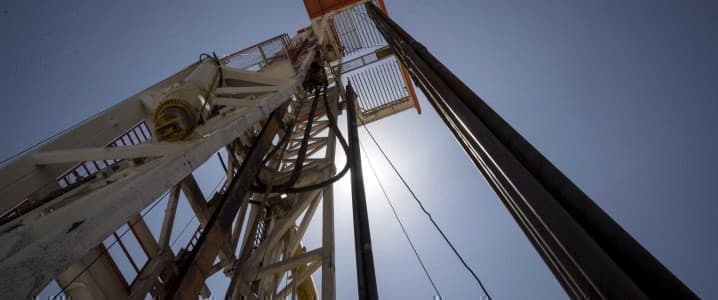European companies have signed numerous sale and purchase agreements for U.S. LNG since Russia invaded Ukraine.
Sital Mody, natural gas president at energy infrastructure company Kinder Morgan Inc. is highly bullish on the Eagle Ford’s natural gas prospects.
Back in March, the U.S. Energy Information Administration predicted that the country’s natural gas production will decline in 2024 at a time when demand is expected to hit a record high.
Natural gas markets have recorded a sharp spike in the current week with Henry Hub prices jumping 24% to $2.06/MMBtu as Europe mulls cutting off more Russian gas. Last month, EU energy chief Kadri Simson signaled that the EU executive has “no interest” in pushing Kyiv to renew its 5-year contract with Moscow, responsible for the supply of ~5% of Europe’s gas. TotalEnergies (NYSE:TTE) CEO Patrick Pouyanne has predicted that natural gas and LNG prices will spike after EU sanctions Russian gas from the Yamal LNG project. Traders are also concerned about the possibility of a harsh European winter after going through two mild winters in a row.
However, these fears could be overblown with Europe’s biggest gas supplier experiencing a natural gas boom. European companies have signed numerous sale and purchase agreements for U.S. LNG since Russia invaded Ukraine, most of which are for 20 years. Last year, Europe imported 167 bcm of LNG, ~46% from the U.S. With Europe’s gas appetite set to continue growing, the Eagle Ford shale of South Texas, traditionally an oil play, is increasingly exploring its gassier side. The second-largest U.S. shale basin came into sharp focus in March when TotalEnergies revealed plans to acquire the 20% interest held by Lewis Energy Group in the Dorado leases operated by EOG Resources Inc. (NYSE:EOG) in the Eagle Ford shale gas play. The Dorado field will allow TotalEnergies to increase its U.S. natural gas production by 50 Mcf/d (million cubic feet a day) in the current year, with the potential for an additional 50 Mcf/d by 2028. This implies the Dorado field could supply nearly a third of TotalEnergies’ U.S. natural gas output of 340 Mcf/d. With over 10 million tons (Mt) in 2023, TotalEnergies was the number one exporter of U.S. LNG.
The Eagle Ford is home to nearly 100 oil and gas companies, including Big Oil names such as BP Inc. (NYSE:BP), ConocoPhillips (NYSE:COP), Devon Energy Corp. (NYSE:DVN), Hess Corp. (NYSE:HES), Shell Plc (NYSE:SHEL), Pioneer Natural Resources (NYSE:PXD) and CNOOC (China National Offshore Oil Corporation).
Eagle Ford Gas Boom
Sital Mody, natural gas president at energy infrastructure company Kinder Morgan Inc. (NYSE:KMI), is highly bullish on the Eagle Ford’s natural gas prospects. Mody has predicted strong production growth by the Eagle Ford Shale out to 2030 thanks to the favorable economics and low nitrogen content of natural gas produced in the basin. According to data from S&P Global Commodity Insight, natural gas production from the Eagle Ford Shale averaged 5.2 Bcf/d in 2023; Kinder Morgan has forecast that production will grow by another 2.5 Bcf/d, or nearly 50%, by 2030, and probably rival that of the Haynesville.
Kinder Morgan sees opportunities to blend high-nitrogen gas from the Permian with Eagle Ford’s low-nitrogen gas to serve demand for nitrogen-sensitive LNG customers on the Gulf Coast. LNG producers typically maintain nitrogen content below 1% to maximize the heating value of the gas and prevent damage to storage tanks.
“As the Permian gains market share to serve these LNG facilities … it’s going to be a bigger issue. We do believe that the low nitrogen content that’s in the lean Eagle Ford will be of value as you start to satisfy all the incremental LNG demand,” Mody told investors.
Last month, Kinder Morgan reported that its natural gas pipeline segment recorded a boost from higher margins realized on its storage assets and higher volumes on its gathering systems. On the earnings conference call, CEO Kim Dang said he expects “significant new natural gas demand” rising from energy-intensive tech such as AI, crypto mining and data centers.
“We expect demand for natural gas to grow substantially between now and 2030, led by more than a doubling of demand for liquefied natural gas exports and a more than 50% increase in exports to Mexico,” Dang said.
“The emphasis on renewables as the only sources of power is fatally flawed,” Dang added, arguing that Big Tech leaders, “like the rest of us, realize that the wind doesn’t blow all the time and the sun doesn’t shine all the time.”
Back in March, the U.S. Energy Information Administration (EIA) predicted that the country’s natural gas production will decline in 2024 at a time when demand is expected to hit a record high. According to the EIA, dry gas production will ease from a record 103.79 billion cubic feet per day (bcfd) in 2023 to 103.35 bcfd in 2024 as several producers lower their drilling activities thanks to low gas prices. However, the EIA sees output rebounding in 2025 to 104.43 bcfd as gas prices recover.
By Alex Kimani for Oilprice.com
More Top Reads From Oilprice.com:
Large Crude Inventory Build Rocks Oil PricesOPEC Resolves Compensation Plans for Overproducing MembersExxonMobil Underwhelms With Q1 Earnings
>>> Read full article>>>
Copyright for syndicated content belongs to the linked Source : OilPrice – https://oilprice.com/Energy/Natural-Gas/The-Eagle-Ford-Is-Turning-Into-A-Natural-Gas-Haven.html






























